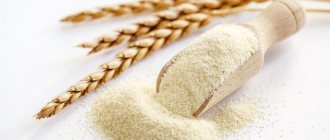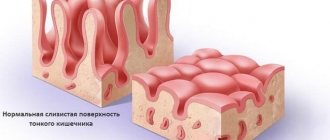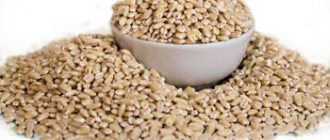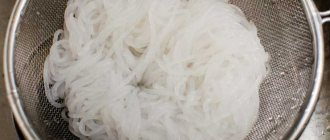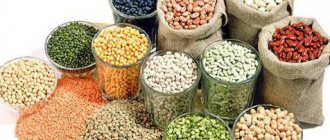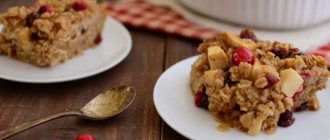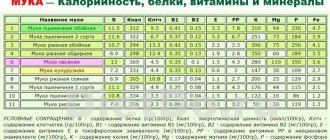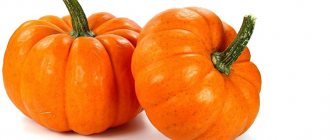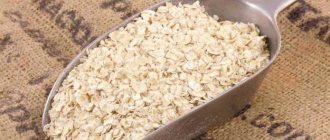Calorie table for porridges from various cereals
Cereals are the oldest food product that has been present in the human diet for more than 10 thousand years.
Our ancestors were actively involved in their cultivation, as they knew about their beneficial properties. The popularity of cereals and grain crops is due to the rich nutrients they contain. More than 70% of most cereals are carbohydrates, a natural source of energy. They also contain fiber and a complex of minerals that ensure the normal functioning of the human body. Cereals are ground into flour for baking, jelly is boiled and porridges and side dishes are prepared for meat dishes. WEIGHT LOSS STORIES OF STARS!
Irina Pegova shocked everyone with her weight loss recipe: “I lost 27 kg and continue to lose weight, I just brew it at night. » Read more >>
Table of calories and nutrients in 100 grams of dry cereals.
| Cereal name | Proteins, g | Fats, g | Carbohydrates, g | Calorie content, kcal |
| Rice | 6,9 | 1,5 | 71 | 329 |
| Manna | 10,7 | 0,9 | 70 | 333 |
| Buckwheat | 12 | 3 | 61,8 | 321 |
| Wheat | 15 | 3 | 64 | 318 |
| Millet | 11,6 | 3,3 | 61 | 348 |
| Oatmeal | 11,3 | 5,7 | 58 | 316 |
| Hercules | 12,03 | 6,02 | 62 | 340 |
| Barley | 9,5 | 1,2 | 64 | 312 |
The table shows the energy and nutritional value (BJU) of cooked cereals without adding sugar, salt and butter.
| Cereal name | Method of preparing porridge | Squirrels | Fats | Carbohydrates | Calorie content |
| Rice | On the water | 1,6 | 0,1 | 17,4 | 80 |
| With milk | 2,7 | 3 | 16 | 101 | |
| Manna | On the water | 2,6 | 0,2 | 16,3 | 82 |
| With milk | 3,4 | 3,5 | 15,2 | 110 | |
| Buckwheat | On the water | 4,2 | 1,3 | 21 | 108 |
| With milk | 5,6 | 3 | 28 | 113 | |
| Wheat | On the water | 3,5 | 0,8 | 21,2 | 107 |
| With milk | 4 | 4 | 19,8 | 137 | |
| Millet | On the water | 3,2 | 0,7 | 19 | 105 |
| With milk | 4,3 | 4,4 | 16,3 | 123 | |
| Oatmeal | On the water | 3,2 | 2,1 | 16,5 | 99 |
| With milk | 3,8 | 4,3 | 16,2 | 114 | |
| Hercules | On the water | 2,9 | 2 | 15,9 | 98 |
| With milk | 1,6 | 3 | 12 | 111 | |
| Barley | On the water | 2,7 | 0,3 | 16,5 | 78 |
| With milk | 3,8 | 2 | 19 | 110 |
Each cereal has a unique composition, so it is advisable to alternate their use. You should not limit yourself to just one type of grain, as this will lead to rapid satiety. The rate of consumption of cereals is calculated based on the age, weight and type of activity of a person. Doctors recommend that athletes and people whose profession involves physical activity increase the calorie content of their diet.
The daily intake of cereal for a school-age child is 40 grams, for an adult – 50-60 grams.
For people who want to lose excess weight, nutritionists recommend eating cereals without added sugar and butter, as they increase the calorie content of cereals. To improve the taste of the porridge, you can add dried fruits, cottage cheese or low-fat yogurt, as well as fresh fruits and berries, such as pumpkin, apples, strawberries or blueberries.
The beneficial properties of ready-made porridges from various cereals are reflected in the table.
Recipe: Porridge 5 grains in water. Calorie, chemical composition and nutritional value.
Nutritional value and chemical composition of “5-grain porridge on water.”
The table shows the nutritional content (calories, proteins, fats, carbohydrates, vitamins and minerals) per 100 grams of edible portion.
| Nutrient | Quantity | Norm** | % of the norm in 100 g | % of the norm in 100 kcal | 100% normal |
| Calorie content | 58.5 kcal | 1684 kcal | 3.5% | 6% | 2879 g |
| Squirrels | 2.2 g | 76 g | 2.9% | 5% | 3455 g |
| Fats | 0.6 g | 56 g | 1.1% | 1.9% | 9333 g |
| Carbohydrates | 10.7 g | 219 g | 4.9% | 8.4% | 2047 g |
| Alimentary fiber | 0.5 g | 20 g | 2.5% | 4.3% | 4000 g |
| Water | 85.1 g | 2273 g | 3.7% | 6.3% | 2671 g |
| Ash | 0.134 g | ~ | |||
| Vitamins | |||||
| Vitamin B1, thiamine | 0.109 mg | 1.5 mg | 7.3% | 12.5% | 1376 g |
| Vitamin B2, riboflavin | 0.008 mg | 1.8 mg | 0.4% | 0.7% | 22500 g |
| Vitamin B4, choline | 3.19 mg | 500 mg | 0.6% | 1% | 15674 g |
| Vitamin B5, pantothenic | 0.088 mg | 5 mg | 1.8% | 3.1% | 5682 g |
| Vitamin B6, pyridoxine | 0.019 mg | 2 mg | 1% | 1.7% | 10526 g |
| Vitamin B9, folates | 1.817 mcg | 400 mcg | 0.5% | 0.9% | 22014 |
| Vitamin E, alpha tocopherol, TE | 0.126 mg | 15 mg | 0.8% | 1.4% | 11905 g |
| Vitamin H, biotin | 1.58 mcg | 50 mcg | 3.2% | 5.5% | 3165 g |
| Vitamin K, phylloquinone | 0.2 mcg | 120 mcg | 0.2% | 0.3% | 60000 g |
| Vitamin RR, NE | 0.3634 mg | 20 mg | 1.8% | 3.1% | 5504 g |
| Niacin | 0.079 mg | ~ | |||
| Macronutrients | |||||
| Potassium, K | 26.07 mg | 2500 mg | 1% | 1.7% | 9590 g |
| Calcium, Ca | 7.9 mg | 1000 mg | 0.8% | 1.4% | 12658 g |
| Magnesium, Mg | 19.65 mg | 400 mg | 4.9% | 8.4% | 2036 |
| Sodium, Na | 2.34 mg | 1300 mg | 0.2% | 0.3% | 55556 g |
| Sera, S | 7.79 mg | 1000 mg | 0.8% | 1.4% | 12837 g |
| Phosphorus, P | 37.6 mg | 800 mg | 4.7% | 8% | 2128 g |
| Chlorine, Cl | 6.95 mg | 2300 mg | 0.3% | 0.5% | 33094 g |
| Microelements | |||||
| Iron, Fe | 0.285 mg | 18 mg | 1.6% | 2.7% | 6316 g |
| Yod, I | 0.47 mcg | 150 mcg | 0.3% | 0.5% | 31915 g |
| Cobalt, Co | 0.395 mcg | 10 mcg | 4% | 6.8% | 2532 g |
| Manganese, Mn | 0.3032 mg | 2 mg | 15.2% | 26% | 660 g |
| Copper, Cu | 36.06 mcg | 1000 mcg | 3.6% | 6.2% | 2773 g |
| Molybdenum, Mo | 1.347 mcg | 70 mcg | 1.9% | 3.2% | 5197 g |
| Selenium, Se | 2.283 mcg | 55 mcg | 4.2% | 7.2% | 2409 g |
| Fluorine, F | 87.75 mcg | 4000 mcg | 2.2% | 3.8% | 4558 g |
| Zinc, Zn | 0.2449 mg | 12 mg | 2% | 3.4% | 4900 g |
| Digestible carbohydrates | |||||
| Starch and dextrins | 4.748 g | ~ | |||
| Mono- and disaccharides (sugars) | 0.1 g | max 100 g | |||
| Essential amino acids | |||||
| Arginine* | 0.065 g | ~ | |||
| Valin | 0.05 g | ~ | |||
| Histidine* | 0.021 g | ~ | |||
| Isoleucine | 0.036 g | ~ | |||
| Leucine | 0.056 g | ~ | |||
| Lysine | 0.037 g | ~ | |||
| Methionine | 0.011 g | ~ | |||
| Methionine + Cysteine | 0.036 g | ~ | |||
| Threonine | 0.034 g | ~ | |||
| Tryptophan | 0.017 g | ~ | |||
| Phenylalanine | 0.047 g | ~ | |||
| Phenylalanine+Tyrosine | 0.086 g | ~ | |||
| Nonessential amino acids | |||||
| Alanin | 0.043 g | ~ | |||
| Aspartic acid | 0.081 g | ~ | |||
| Glycine | 0.09 g | ~ | |||
| Glutamic acid | 0.172 g | ~ | |||
| Proline | 0.057 g | ~ | |||
| Serin | 0.045 g | ~ | |||
| Tyrosine | 0.04 g | ~ | |||
| Cysteine | 0.025 g | ~ | |||
| Saturated fatty acids | |||||
| Saturated fatty acids | 0.1 g | max 18.7 g | |||
| 14:0 Miristinovaya | 0.002 g | ~ | |||
| 16:0 Palmitinaya | 0.104 g | ~ | |||
| 18:0 Stearic | 0.005 g | ~ | |||
| Monounsaturated fatty acids | 0.17 g | min 16.8 g | 1% | 1.7% | |
| 18:1 Oleic (omega-9) | 0.169 g | ~ | |||
| Polyunsaturated fatty acids | 0.184 g | from 11.2 to 20.6 g | 1.6% | 2.7% | |
| 18:2 Linolevaya | 0.18 g | ~ | |||
| 18:3 Linolenic | 0.004 g | ~ | |||
| Omega-6 fatty acids | 0.2 g | from 4.7 to 16.8 g | 4.3% | 7.4% |
The energy value of 5-grain porridge with water is 58.5 kcal.
Primary Source: Created in the application by the user. Read more.
** This table shows the average levels of vitamins and minerals for an adult. If you want to know the norms taking into account your gender, age and other factors, then use the “My Healthy Diet” application.
What determines the calorie content of cereals?
Most cereals are based on carbohydrates, 75%, the rest are proteins and fats. Grains are a natural source of energy. They are rich in fiber, many micronutrients and vitamins.
The calorie content of each type of cereal depends on the ratio of BZHU in it. The more complex carbohydrates and fatty acids a product contains, the higher the energy composition of the cereal.
The greatest usefulness is preserved with minimal processing of the dry ingredient. Many manufacturers, before packaging, steam, grind or crush the grains. This procedure significantly reduces the valuable qualities of cereals, but at the same time increases their calorie content.
Calorie content of different types of cereals in dry form: table
Today, there are a huge number of different types of cereals on store shelves.
Determining the energy component of a product is not difficult. To do this, you do not need to constantly have a bunch of tables or diagrams on hand. All information about the composition of the product can be obtained by carefully studying the packaging. Products sold by weight in supermarkets must have a detailed description.
The most commonly consumed cereals in our region include buckwheat, rice, pearl barley, peas and, of course, oatmeal. White rice is considered the highest calorie among raw ingredients, and oats are considered the most dietary. The calorie content of cereals in the table is indicated in descending order.
Calorie content of different types of cereals in finished form
As a rule, the calorie content of the dry ingredient and the finished dish do not match. This is explained by the fact that during the cooking process the component changes its structure, becomes soft, and becomes heavier.
The calorie content of prepared food is influenced by several factors:
- original ingredient;
- what the food is prepared with: water, milk (the percentage of fat content is taken into account);
- the presence of additional spices (sugar, salt) and additives (butter, honey, dried fruits, berries).
The less additional components are used during the cooking process, the more dietary the finished dish will be. People who want to lose weight are recommended to eat porridge in the first half of the day.
Calorie content of porridge with water (table) in 100 grams
The most dietary option for preparing cereals is boiling them in water. Under the influence of liquid, the grains swell and become heavier. A hundred gram volume of finished food will have less calories than the same amount of dry matter.
Table No. 2. Calorie content of a dish boiled in water (per 100 g)
| Variety of cereals | Kcal |
| Lentil | 111 |
| Wheat | 107 |
| Buckwheat | 98 |
| Millet | 91 |
| Oatmeal | 85 |
| Pea | 89 |
| Barley | 76 |
| Pearl barley | 63 |
Calorie content of porridge with milk: table
Including milk will add extra calories to the dish. However, you should not neglect milk porridges. The product contains a lot of protein, healthy fats, and calcium.
If you do not add sugar, salt, or vegetable oil to the finished dish, then porridge with milk will absolutely not harm your figure.
Table No. 3. Calorie content of porridge boiled in milk (per 100 g)
| Variety of cereals | Kcal |
| Wheat | 127 |
| Hercules | 135 |
| Manna | 105 |
| Millet | 123 |
| Corn | 120 |
| Oatmeal | 104 |
| Barley | 110 |
| Rice | 97 |
Is it possible to eat porridge on a diet?
Experts in the field of proper nutrition recommend eating porridge for breakfast. Cereals are quite a filling and nutritious option for a morning meal.
In order for the product to bring maximum benefit, you should adhere to a number of simple rules:
- Choose whole grains, they contain more protein, fiber, and retain essential microelements and vitamins for humans.
- The ideal version of porridge is in water, without adding other ingredients. Sugar is prohibited. Salt is used to a minimum.
- To add flavor, the food can be flavored with a spoonful of honey, pieces of vegetables, fruits, berries, nuts, and herbs.
- The most effective option is to alternate different types of grain. The body receives varied and healthy nutrition throughout the week.
A special express diet has been developed based on cereals. It is designed for 3-5 days. During this period, you are allowed to eat only porridges prepared using a special method.
- Ø pour 4.5 tablespoons of cereal (buckwheat, oatmeal) into a container;
- Ø pour boiling water over the mixture;
- Ø leave tightly wrapped for 20-30 minutes;
- Ø add a little water, boil for 5 minutes;
- Ø Divide into 3 portions;
- Ø Consume warm during the day.
In addition to cereals, it is allowed to drink fermented milk products and 200 g of unsweetened fruits or vegetables.
However, most nutritionists recommend extremely rarely resorting to all kinds of diets. Getting your figure in order without harming your health is possible only with a balanced diet and physical activity.
Tasty and healthy
For dietary nutrition, you can choose low-calorie cereals that will help you get rid of a few extra pounds in the shortest possible time.
- It is recommended to cook them in milk with minimal addition of salt.
- To improve the taste, you can add some fresh or frozen berries or dried fruits to the porridge.
- To get the benefits of porridge for weight loss, do not overcook it. Therefore, it is better to select those cereals that swell in water.
- To prepare a glass of grains, pour two glasses of very hot water and leave overnight. And in the morning, set it to cook, bring it to a boil, and immediately turn it off. Then let the porridge sit under the lid and you can eat it.
This simple cooking method will not only reduce the calorie content finished dish, but also preserve vitamins, microelements and fiber intact. Thanks to the variety of cereals, you can choose the one that has the lowest calorie content and will not leave you hungry even with dietary restrictions. To prepare it for dietary purposes, try to add a minimum amount of ingredients to the plate that increase the energy value, and then you won’t have to worry.
There is also a recommendation regarding where it is best to cook porridge so that it brings maximum benefits. In the modern world, many people do not have free time to cook, and therefore microwave ovens have become popular, minimizing the cooking time. But they are not recommended for use with porridges for diets - due to the negative impact on the properties of the dish.
After microwaving food, the glycemic index increases significantly, which shows the level of sugar in a person’s blood during a meal. This is due to the fact that magnetic waves neutralize the starch found in cereals. As a result, complex carbohydrates are easier to process, and the body will not need much time to digest such porridge. So when preparing porridge for a diet, it is better to do without this device.
Calorie content of porridge depending on the method of preparation
Contrary to popular belief, cereals do not contribute to weight gain. Based on the fact that the average woman’s diet should consist of 1400 kcal, and the average serving of porridge is approximately 300-400 g, the calorie content of porridge allows nutritionists to consider these dishes an ideal breakfast.
Based on 100 g of finished product, the calorie content of water-based porridges, which are especially popular among our compatriots, is as follows:
- Rice – 120 kcal;
- Wheat – 170 kcal;
- Wheat with pumpkin – 100 kcal;
- Oatmeal – 140 kcal;
- Semolina – 100 kcal;
- Corn – 86 kcal;
- Barley – 130 kcal;
- Pearl barley – 160 kcal.
Calorie content of corn porridge
Corn porridge is less popular than buckwheat or rice. But at the same time, it has a number of beneficial properties, therefore it is recommended for dietary nutrition. Before talking about how many calories are in water porridge, it is worth saying a little about its beneficial properties.
Constant consumption of corn dishes improves metabolism, thereby improving the condition of skin and hair. The fibers included in the composition stop the processes of food rotting in the intestines. Corn rarely causes allergies and is considered a good remedy for preventing heart disease.
100 g of corn porridge contains slightly less than 81 kcal
Corn belongs to the group of complex carbohydrates, therefore it is recommended for dietary nutrition. It gives you a feeling of fullness for a long time and energizes you.
How many calories are in corn porridge with water is determined by the additives and method of preparation. Simple corn porridge contains a minimal amount of calories. 100 g of the finished product contains slightly less than 81 kcal.
Due to the low calorie content of the dish, eating corn porridge is not recommended for those who are on a weight gain diet. Unlike some other types of porridge, corn porridge has contraindications: it is better to exclude it from the diet if you have an individual intolerance, as well as with diseases of the stomach and duodenum, especially if they occur in an acute form.
Favorite porridges - calorie content and other advantages
Oatmeal is loved by gourmets, nutritionists and adherents of a healthy lifestyle all over the world. Oatmeal is a source of selenium, a natural antioxidant, as well as B vitamins and coarse dietary fiber. It has been proven that oatmeal helps normalize the level of “bad” cholesterol in the human body and has a beneficial effect on the condition of the skin and mucous membranes. The calorie content of oatmeal is 140 kcal. The low calorie content of oatmeal makes it indispensable in the diet of people suffering from excess body weight, while cereals are considered the most useful, and not cereals, muesli and other instant foods.
Semolina porridge, popular among our compatriots in the recent past, has not earned such a high rating from nutritionists. Moreover, today its role even in baby food is very doubtful. The calorie content of semolina porridge cooked with milk is 120 kcal. Despite the low calorie content of semolina porridge, it is so-called fast carbohydrates, that is, empty calories and does not have any nutritional value.
Millet is rich in manganese, copper and zinc. Residents of modern megacities are recommended to include millet porridge in their diet as a natural adsorbent, since it has the ability to remove excess amounts of harmful substances from the body.
Millet should be stored in a dry, dark place and not exceed the time recommended by the manufacturer. Otherwise, the fats contained in the cereal may go rancid and lose their delicate taste and valuable characteristics. The calorie content of millet porridge with water is 109 kcal, and the calorie content of millet porridge with milk is 130 kcal. At the same time, it gives you a feeling of satiety for a long time and fully. It is believed that millet porridge should be included in the menu of people with various heart pathologies in order to strengthen the heart muscle. In addition, it has a certain anti-cholesterol effect.
Buckwheat porridge is a symbol of Russian cuisine. Buckwheat is rich in iron, vitamin B2, magnesium and other valuable elements. It also contains large amounts of coarse indigestible fiber and vegetable protein. For many chronic diseases, buckwheat is recommended as part of the diet. In Mediterranean countries, buckwheat can be purchased in pharmacies.
The most valuable is buckwheat porridge made from whole grains, boiled in water or steamed. The calorie content of the porridge is 329 kcal.
Cooking options and calorie content
Many cereals contain large amounts of such a healthy trace element as potassium. In particular, it has a beneficial effect on the functioning of the heart muscle. They also contain calcium, which strengthens bone tissue, teeth and nails. This element is especially important for children and elderly people whose bones are fragile. Many other types of cereals contain magnesium, which stimulates the normal functioning of the nervous system, and iron, which improves blood composition.
Porridges are also famous for their high content of B vitamins, which are considered natural antidepressants. They strengthen the nervous system, improve mood, increase activity and performance, enhance attention and memory, and also help normalize sleep. Buckwheat has the highest content of vitamin B. If you look at its calorie content, it is quite high. One hundred grams of raw buckwheat contains 330 calories. For comparison, a little more (385 kcal) is contained in shortbread cookies. But the trick with cereals is that the calorie content of cereals will be several times higher than the final energy value of the finished dish. This happens because, when saturated with water, the cereal increases three to five times, while the amount of energy obtained when a person eats one hundred grams becomes smaller.
The calorie content of water-based porridges can vary significantly if they are prepared with different amounts of moisture. The more water you add to the porridge, the fewer calories it will contain. Therefore, even the lowest calorie porridge in dry form can frighten an ignorant person with its calorie content. So, in its finished state, buckwheat cooked in water has a calorie content of 100–165 calories per hundred grams, depending on the preparation method. The lowest energy value of a dish can be obtained by making a viscous porridge, but a crumbly one will be more nutritious.
If you cook buckwheat with milk, the index will also increase and amount to 118 kcal per 100 grams. In general, the calorie content of porridge with milk is about half higher than if it was cooked in water without adding butter or vegetable oil. On average, the calorie content of any porridge cooked in water varies from 90 to 120 kcal per hundred grams. But the average porridge with milk will be about 130–160 kcal for the same amount. But such dishes are an excellent breakfast for children, whose growing bodies require a higher calorie content of food. Milk porridge will also provide athletes who spend a lot of energy in the gym or at the stadium with the necessary energy in the morning.
Calorie content of porridge with milk
Porridge is traditionally considered an important component of Russian cuisine.
They were a mandatory part of the diet of our ancestors and are no less popular today. Porridge is certainly a healthy product, since it is prepared from cereals. A distinctive feature of such crops is the content in their composition of so-called slow carbohydrates, which release energy for a long time and are practically not absorbed by the body. This helps keep you feeling full longer. In order to improve the taste characteristics of porridges, from ancient times they began to be prepared not only with water, but also with milk, when there was such an opportunity. Naturally, the calorie content of porridge with milk was much higher, but at the same time, milk added beneficial properties to the porridge.
How calories increase with supplements
The final energy value of any porridge is influenced not so much by what it was cooked with, but by what was put into it to improve its taste. With abundant flavoring with various additives, even the lowest-calorie cereal will turn from a dietary dish into a dessert or culinary delight with all the ensuing consequences for the waist. Even the addition of such a seemingly harmless spice as salt can greatly harm the dietary properties of cereals. If you often overdo it with its quantity, this will lead to the fact that water metabolism in the human body will be disrupted, which will be reflected in the appearance of swelling. And although salt does not add calories to dishes, it slows down metabolism, which will be more serious than the problem with the increased calorie content of the product.
But sugar directly affects energy value, as well as the amount of carbohydrates. A person who wants to lose weight must carefully calculate his daily diet so that it is as complete as possible. This means that the amount of proteins, fats and carbohydrates per day should be strictly fixed depending on the personal characteristics of a person (weight, age, height, physique, gender, and so on). In this case, you will have to reduce as much as possible the amount of sugar, which contains a large amount of fast carbohydrates. And if in terms of caloric content one teaspoon of sugar contains 32 kcal, then it contains 10 grams of carbohydrates, which can be a decisive factor for creating a menu for the day. In addition, the effect of fast carbohydrates is fleeting, which means that after half an hour you will again want to sweeten your life with dessert.
Oil has a strong effect on the calorie content of boiled cereal. For example, one teaspoon of sunflower oil will add 45 calories to any porridge, and a tablespoon - all 180. Butter will add a pleasant delicate flavor to the dish, as well as extra calories: a teaspoon - 112.5 kcal, a tablespoon - 300 kcal. And the range of additives that can be added to these side dishes is far from limited. Milk porridges are often flavored with various spices and decorated with dried fruits, and cereals cooked in water are made more tasty thanks to spicy sauces.
Popular supplements and their calorie content
| Name | Kcal/100 g |
| Soy sauce | 50 |
| Tomato | 100 |
| Sour cream and garlic | 205 |
| Cinnamon | 245 |
| Ground black pepper | 255 |
| Saffron | 310 |
| Cardamom | 315 |
| Dried apricots | 232 |
| Peanut | 551 |
| Dried bananas | 96 |
| Walnut | 656 |
| Dried pear | 250 |
| Raisin | 265 |
The benefits of porridge with milk
Any cereals themselves are a source of nutrients necessary for the human body. Most of them contain B vitamins, which contribute to the normal functioning of the nervous system, as well as vitamins A, PP and D. Vitamin E, contained in cereals, prolongs youth and improves skin condition. In addition to vitamins, porridges are rich in minerals. They contain elements such as phosphorus, which strengthens bones and teeth, selenium and zinc, which promote hair growth and health, as well as magnesium, without which it is impossible to maintain the health of the cardiovascular system. The list of all the beneficial substances included in cereals can take up a whole page, which indicates their unconditional benefits for the body.
Despite the fact that the calorie content of porridges with milk increases significantly, the addition of this product helps to improve the vitamin and mineral composition of any porridge. The point is that as a result of adding milk, the porridge contains more calcium, protein and other beneficial substances that make up milk. By eating one serving of porridge with milk, you can get double the benefits. Those who are concerned about the calorie content of porridges made with milk can be advised to use milk with less fat content. But you shouldn’t completely give up cooking porridge with milk.
Oatmeal (rolled oatmeal)
What is the calorie content of oatmeal?
- Oatmeal with water - 88 calories.
- Oatmeal with milk - 105 calories.
The benefits of oatmeal porridge
- Oatmeal removes toxins and other harmful substances.
- Contains Vitamin H (biotin), which relieves muscle pain.
- Porridge contains a lot of nickel, phosphorus, calcium, and potassium.
- Oatmeal improves skin condition.
- Increases immunity.
- Normalizes metabolism.
Harm of oatmeal porridge
- Phytic acid, which is present in porridge, delays the absorption of calcium in the intestines.
- People who suffer from grain intolerance (celiac disease) should not eat oatmeal.
Preparing oatmeal:
- Grab a glass of oatmeal.
- Take milk (two and a half glasses).
- Three tablespoons of sugar.
- Salt (one teaspoon).
- Cook this entire mixture until done.
- Stir while adding a little strawberry.
Does porridge or oatmeal help you lose weight?
Yes, if you eat these “things” during the day:
- Oatmeal decoctions.
- Oat infusions.
- Baked goods made from oat flour.
- Oatmeal bread.
- Oatmeal cookies.
